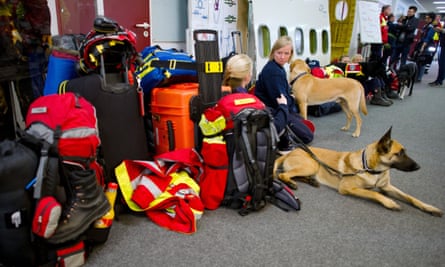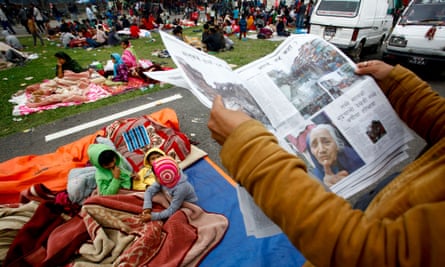Governments are scrambling to locate thousands of their nationals and relatives have taken to social media to find their loved ones in the aftermath of the Nepal earthquake that has killed more than 2,500 people.
China has said it is chartering flights to pick up 683 tourists who were in the Himalayan country when a magnitude 7.9 earthquake hit near Kathmandu on Saturday, reducing parts of the capital to rubble in the worst disaster to hit Nepal in more than 80 years.
Australia’s foreign minister, Julie Bishop, said her government had contacted more than 200 of 549 Australians travelling in Nepal, while New Zealand’s foreign minister, Murray McCully, said more than 110 nationals had been accounted for.
“While there are reports of extensive loss of life, at this point there are no reports of Australian deaths,” Bishop said in a statement on Sunday, adding that staff from the foreign affairs department were travelling to Nepal to help locate other citizens.
Japan’s foreign ministry said it had set up a liaison office to help locate the 1,100 of its nationals who were staying in Nepal when the quake hit, Jiji news agency reported.
The UK’s Foreign Office said it was in close contact with the Nepalese government, with the British embassy offering assistance to the authorities and providing consular assistance to British nationals.
Two British climbers said they were caught in a resultant avalanche on the slopes of Mount Everest. Alex Schneider and Sam Chappatte, both 28, described seeing the avalanche coming directly towards them.
The pair are safe at a camp on the mountain. On their blog, they wrote: “The earthquake hit about 30 minutes after we had crossed the icefall yesterday morning and found our tents.”
They wrote that the “ground started shaking violently” and they were ordered out of their tents and to grab their ice axes by a colleague.
“We staggered out to see an avalanche coming straight at us. A blast of wind knocked us down but we were able to get up and run to shelter behind some tents and anchor ourselves with our axes.”
“Helicopters have been in to pick up the sick and injured,” the climbers added. “We’re OK. We’ve got food and the sherpas are being amazing. We’re OK.”
Other British people were caught up in the aftermath of the quake. According to the BBC, 52-year-old James Grieve was part of a group of five Britons who became trapped on Everest.
Joseph Feeney and Calum Henderson, who were trekking to Nepal, were also stranded but reported to be safe.
34-year-old Jacqueline Toal from Glasgow, who had been reported missing, has since been located and has been in contact with her family, according to the BBC.
Her father, Philip Toal, said: “I was trying not to panic. But when that text [from Jacqueline] came through, there was just elation. We’d heard conflicting stories about where the epicentre was so we didn’t really know what to believe.”
China confirmed that four of its nationals had died and 10 were seriously injured. South Korea said three of its nationals among the estimated 650 residents were injured, as were as many as 1,000 travellers who were in Nepal at the time. Israel estimated that 600 Israelis were in Nepal and had secured contact with 400, most of them sheltering at the embassy in Kathmandu.
France said about 500 of its nationals had been located and were safe, while India had evacuated nearly 800 of its citizens. The Spanish government said it had located 169 Spanish citizens but was still trying to track down a further 165. The number of foreigners is estimated at 300,000 at a busy time of year for the tourism-reliant country’s trekking and climbing season.
Offers of help have poured in from governments around the world, with Japan, China, the US, Russia and the European Union announcing they were sending in disaster response teams. Justine Greening, the UK’s international development secretary, announced a £5m relief package for its partners and the British Red Cross to provide immediate assistance.
Australia has pledged A$5m (£2.5m) in aid, while McCully said New Zealand – still recovering from a deadly quake that hit its second-largest city Christchurch in 2011 – would send NZ$1m (£500,000).

Australians took to social media to express their fears about missing relatives and friends who were working or travelling in Nepal when the quake hit.
Australian television star Hugh Sheridan tweeted about his younger brother in Nepal: “Please. Anyone who is awake, please pray for my little brother Zachary who is on Mt Everest, I’d appreciate every prayer you have spare.”
Please. Anyone who is awake, please pray for my little brother Zachary who is on Mt Everest, I'd appreciate every prayer you have spare x
— Hugh Sheridan (@hugh_sheridan) April 25, 2015
Twitter and Facebook pages are showing images of Australians in Nepal and many families have reported dozens of loved ones missing on the Red Cross’s Family Links website.
One is 24-year-old Sydney business owner Matthew Graves, who was travelling through Pokhara. His brother, Mitch Graves, is at home in Sydney waiting for news while their parents are overseas in the US. “It’s a bit of a struggle trying to communicate to everyone. It is a waiting game at the moment,” Mitch said.
Dan Fredinburg, a senior executive at Google, was among more than a dozen people confirmed killed by an avalanche that swept through Everest base camp.
Tom Briggs, marketing director for Jagged Globe, a Sheffield-based climbing and adventure company, confirmed the news “with the greatest sorrow”. Two other climbers, Paul Greenan, from Dublin, and British-born Richard Brooks, from Sydney, suffered serious but non-life-threatening injuries including broken ribs, arm and pelvis.
“They saw the avalanche coming and were able to make a run for it, but the camp was right in the middle of it,” said Briggs. “Our thoughts and prayers go out to Dan’s family and friends.”
A spokeswoman for Intrepid, a company that arranges treks in Nepal and the Everest region, confirmed it had some groups that included British people in the area and said it was trying to get in touch with the tour groups.
Among the stranded Britons was Daniel Mazur, a Summit Climb expedition leader from Bristol, who tweeted: “A massive earthquake just hit Everest. Base camp has been severely damaged. Our team is caught in camp 1. Please pray for everyone.”
An hour later he said: “Aftershock! Everest team is in camp 1, hanging on. Icefall route destroyed.”
Aftershock @ 1pm! Horrible here in camp 1. Avalanches on 3 sides. C1 a tiny island. We worry about icefall team below.. Alive?
— Daniel Mazur (@danielmazur) April 26, 2015
That was followed by a post linking to the website EverestTibetNews.com that read: “We felt the earthquake on the north side but have no damage and all are safe.”
James Grieve, 52, from Kinross in Fife, Scotland, had become trapped with a party of four others from the UK who were on a Help for Heroes charity climb.
Grieve, an engineer who works in Kazakhstan, managed to speak to his partner Shirley McGhie, 40, in Kinross to let her know he was safe.
She told the Press Association: “He said they were in their tents before the avalanche hit. They were warned to put their ice picks in the ground and hold on as tight as they could.
“He found it difficult to breathe and when it was over they just tried to get some shelter and get some tents erected. They were just really concerned for the others and those that were injured.”

Grieve managed to phone her not long after the avalanche happened on Saturday to allay her fears for his safety.
Neil Laughton, a former Royal Marine commando from London, was thought to be on the north side of the mountain for a PR event billed as the world’s highest dinner party.
He tweeted: “We are all OK! Thank you for your messages. Our thoughts are with all of the victims and their families here in Nepal.”
We are all OK! Thank you for your messages. Our thoughts are with all of the victims and their families here in Nepal
— Neil Laughton (@NeilLaughton) April 25, 2015
Rupa Joshi, a communication officer for Unicef, the UN agency for children, said the quake was like nothing he had experienced in his 57 years.
“When I went out in the evening, I saw many people preparing to camp out in the main open parade ground in the middle of the street,” he said. “Relatives were crying in the main government hospital where the dead were being lined up in front of the hospital building. My family is traumatised. We are five generations living under one roof – from a 100-year-old grandmother to my 16-month-old granddaughter. Strong aftershocks that are keeping most of us up.”